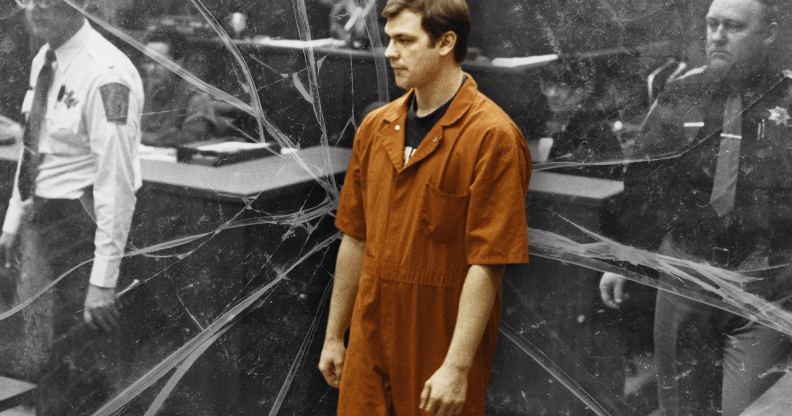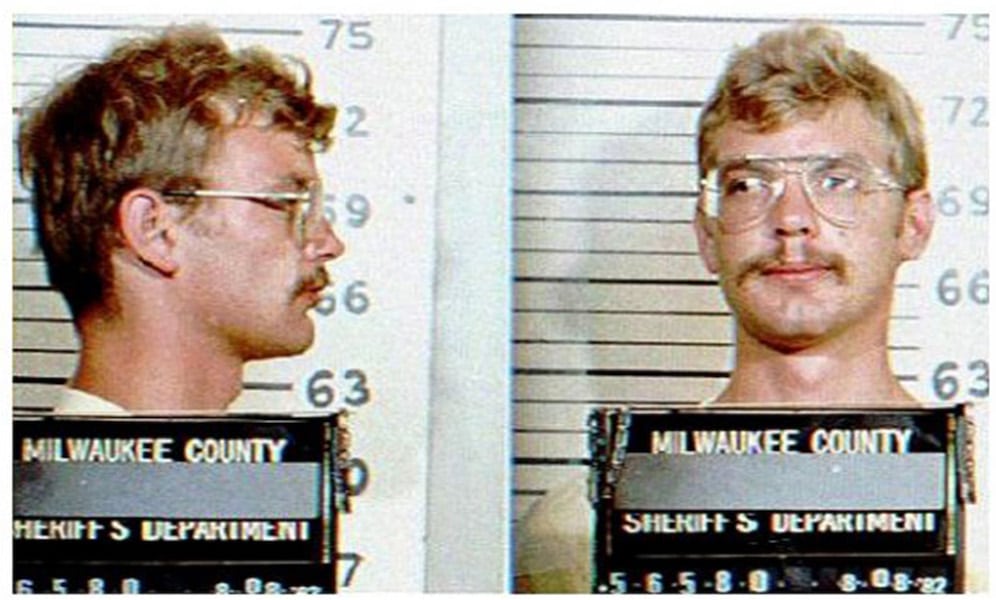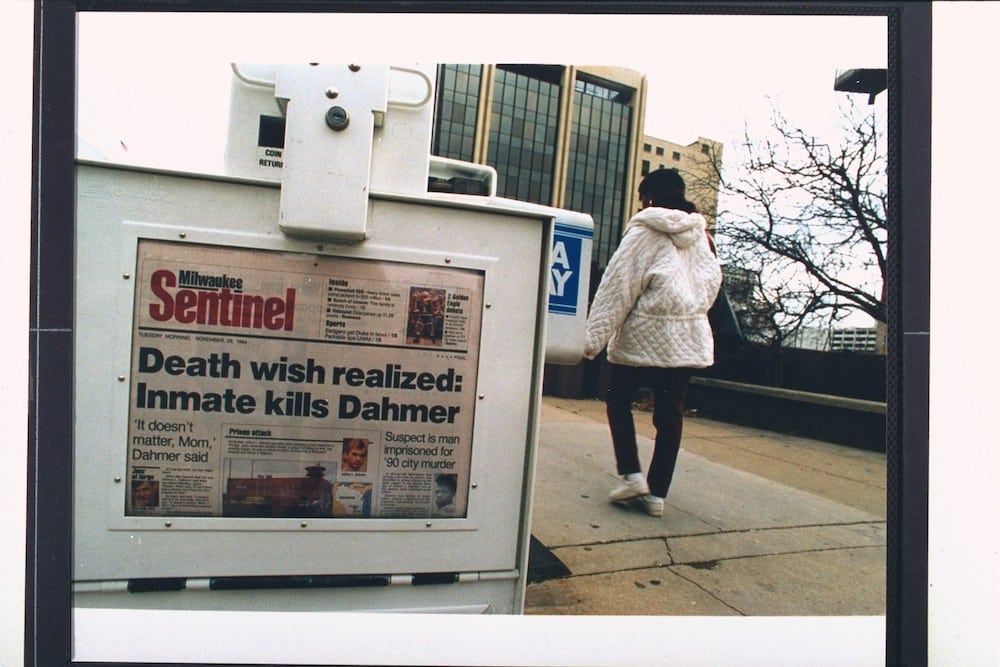Who was Jeffrey Dahmer? The deeply disturbing true story of serial killer behind new Netflix drama

Seneca was sentenced to 45 years in federal prison after committing a crime likened to that of serial killer Jeffrey Dahmer. (Getty)
The latest Netflix true crime drama – DAHMER – landed on Wednesday (21 September), based on the horrific crimes of gay serial killer Jeffrey Dahmer, who murdered 17 men or young boys, between 1978 and 1991.
The series, made by Ryan Murphy – in which Evan Peters impeccably plays Dahmer, has been branded so twisted that some viewers are unable to finish watching, but who was the real killer behind the show?
Content warning – this story contains descriptions of extreme violence, rape and sexual assault.
The Netflix series drops viewers in 1991, when the killer claimed his final victim, but Dahmer’s story begins when he was born on 21 May 1960 in Milwaukee, Wisconsin.
He was the eldest of two sons born to Lionel Dahmer, a scientist and research chemist, and Joyce Dahmer, a teletype machine instructor who suffered with mental illness.
In his younger years, Dahmer is thought to have been deprived of attention, with his father focused on work and his mother unavailable due to the severity of her depression and overuse of prescription medication.
Although in his early years Dahmer was reported to be a happy child, at the age of four he underwent a hernia operation, after which he became increasingly withdrawn.
Throughout his childhood, Dahmer had a fascination with bones. Impressed by his son’s scientific curiosity, his father encouraged the interest and would take Dahmer out to look for roadkill, which he taught him to dissect and instructed him on how to preserve their skeletons.
At around the age of 14, Dahmer began drinking heavily, even throughout the school day.
It was also during his high school years he realised he was gay, but he began having dark sexual fantasies involving unresponsive sexual partners and dissection.

Mugshot of serial killer Jeffrey Dahmer. (Bureau of Prisons/ Getty)
When Jeffrey Dahmer was 18 years old, shortly after his parents divorced, he picked up a hitchhiker named Steven Hicks, who was also 18.
Dahmer invited Hicks back to his house to hang out and drink beer. When Hicks indicated that he would like to leave, however, Dahmer hit him twice from behind with a dumbbell. He then strangled Hicks to death and masturbated over his body.
The next day, Dahmer dismembered Hicks’ body and buried him behind the house. A few weeks later, he dug up his remains to remove the flesh from his bones, before stripping them in acid. He then crushed his skeleton and scattered them in the woods.
Over the next few years, Dahmer would continue to drink heavily, resulting in him dropping out of university after a single term, being discharged from the army for poor performance, being kicked out of his father’s home in Ohio, and eventually moving in with his grandmother in Wisconsin.
While living in Wisconsin, Dahmer began to discover the gay scene in Milwaukee, visiting clubs and bathhouses, and his violent sexual impulses surfaced once more.
Dahmer would regularly offer money to men, asking them to come home with him to model for photos, before drugging them with sleeping pills and raping them. In 1987, when he was 27 years old, he committed his second murder.
Later, Dahmer would claim to have no memory of killing his second victim, Steven Tuomi, instead claiming to have woken up in a hotel to find him dead with his chest “crushed”.
After killing Tuomi, Dahmer placed his victim’s body in a suitcase to bring it back to his grandmother’s house, where he dismembered it, removed the flesh from the bones and discarded the remains – all except Tuomi’s head.
He kept his victim’s head in a blanket for two weeks, before attempting to preserve the skull. He was unsuccessful, and eventually disposed of it.
The murder of Tuomi started a pattern for Dahmer, and between January 1988 and July 1991 he murdered 15 more people – two of whom were just 14 years old, and one of whom, Tony Hughes, was deaf and non-vocal – usually drugging, raping and strangling them, before mutilating their bodies.
During this three-year murder spree, the rate at which he killed rapidly increased, and Dahmer’s rituals, which he often documented using a polaroid camera, became more even disturbing.
In 1989, Dahmer started keep body parts from people he’d murdered, beginning with his fourth victim, 24-year-old victim Anthony Sears, whose preserved skull and genitals he kept in a filing cabinet.
He would go on to keep several skulls, a complete human skeleton, and body parts including hearts, biceps and hands in his freezer.
In an attempt to create what Dahmer would later describe as a “zombie-like state”, he also drilled holes into the skulls of two of his victims while they were still alive, and injected hydrochloric acid into their brains.
One of Dahmer’s 14-year-old victims was subjected to this horrifying experiment, but managed to leave the house, naked and disorientated.
He was found by three women, who called the police, but when officers arrived they accepted Dahmer’s story that the boy was his 19-year-old lover who had had too much to drink. Dahmer killed the victim when they were allowed to return to his apartment.
Residents of Dahmer’s apartment building would often complain of a terrible smell and the sound of a chainsaw, but Dahmer insisted that the smell was because of meat that had gone bad, or the death of his tropical fish.

Jeffrey Dahmer appears at his trial. (Sigma via Getty/ Marny Malin)
In 1991, Jeffrey Dahmer approached three men in a bar, one of whom – 32-year-old Tracy Edwards – accepted his offer of $50 to return to his apartment and pose for photographs.
Once there, the man noticed an overpowering smell, boxes of hydrochloric acid, and a huge vat in Dahmer’s bedroom. But when he attempted to leave, Dahmer handcuffed him and threatened him with a knife, before informing his that he was going to remove his heart and eat it.
But Edwards managed to placate Dahmer, eventually punching him in the face, fleeing, and flagging down two police officers.
The officers accompanied Edwards to the apartment, where they found Dahmer, multiple skulls, a variety of human body parts, and polaroid pictures showing his victims in various states of dismemberment.
Horrifyingly, kitchen equipment showed Dahmer had likely been cooking and eating some of the human remains.
He was immediately arrested for the attempted murder of Edwards, and once in custody confessed to all 17 murders.
‘An incessant and never-ending desire to be with someone at whatever cost’
During more than 60 hours of police interviews, Dahmer detailed his crimes, and revealed he had regularly engaged in necrophilia, and had eaten the hearts, livers, biceps and thighs of several victims after tenderising, seasoning and cooking them.
He told police he had been preserving his victims skulls and skeletons to build an altar, where he could “meditate” and “feel at home”.
Asked about the rapidly increasing rate of the murders, he said: “It was an incessant and never-ending desire to be with someone at whatever cost. Someone good looking, really nice looking. It just filled my thoughts all day long.”
Dahmer pleaded guilty to 16 murder charges. He was not charged with the attempted murder of Tracy Edwards, nor the murder of Steven Tuomi, which he said he did not remember committing.
In January 1992, Dahmer’s trial began. It was not a trial to ascertain whether he had committed the crimes, as he had already confessed, but to decide whether he was responsible for the murders, or whether he was “guilty but insane”.
Psychiatrists for the prosecution and defence, as well as independent psychiatrists, gave evidence at trial, and all agreed that Dahmer had serious mental health problems.
However, he was found to be legally sane, with psychiatrist for the defence Park Dietz telling the court: “Dahmer went to great lengths to be alone with his victim and to have no witnesses.”
In a statement at his sentencing, Dahmer told the judge that he wished to die, although the death penalty had long been abolished in Wisconsin.
“I know my time in prison will be terrible, but I deserve whatever I get because of what I have done,” he said.
“Thank you, your honour, and I am prepared for your sentence, which I know will be the maximum. I ask for no consideration.”
Dahmer was sentenced to 16 life sentences.

Newspaper vending machine shows a headline that reads: “Death wish realised: Inmate kills Dahmer. (Getty/ Steve Kagan)
Despite Jeffrey Dahmer’s extremely long sentence, he spent just two years in prison before his death.
During that time, he converted to Christianity, was baptised, and maintained regular contact with his parents.
On 28 November 1994, Dahmer was murdered by a fellow inmate when he was beaten with a metal bar in the prison bathroom. He was still alive after the attack, but declared dead an hour later in hospital.
His killer also murdered another inmate at the same time, and upon returning to his cell, told guards: “God told me to do it.”

